Page 53 of 299

Child safety51
Safety FirstOperating instructionsTips and MaintenanceTe c h n i c a l D a t a
ISOFIX child seat mounting system
ISOFIX child seats can be mounted in the second and third
row seats quickly, safely and easily.When removing or fitting the child seat, please be sure to follow the
manufacturer's instructions.
– Press the child seat onto the ISOFIX retaining rings �Ÿfig. 33
(arrows) until the child seat can be heard to engage securely.
– Pull on both sides of the child seat to ensure that it is secure.
When a child seat is mounted in seats equipped with the “ISOFIX” system,
the backrest should be fitted in one of two positions �Ÿfig. 34 or .
Two ISOFIX retaining rings are secured to the body behind the seats in the
second and third rows. The ISOFIX retaining rings are attached to the seat
frames.
Child seats with ISOFIX mountings are available from Authorised SEAT Service
Centres.
WARNING
•The retaining rings are designed only for use with ISOFIX child seats.
•Never secure retaining belts, objects or non-ISOFIX child seats to the
fastening rings. Risk of fatal accidents.
Fig. 33 Retaining rings
for ISOFIX child seats in
the frames of the outer
seats in the second row of
seats
Fig. 34 Backrest adjust-
ment when using ISOFIX
child seats
A1A2
Page 54 of 299
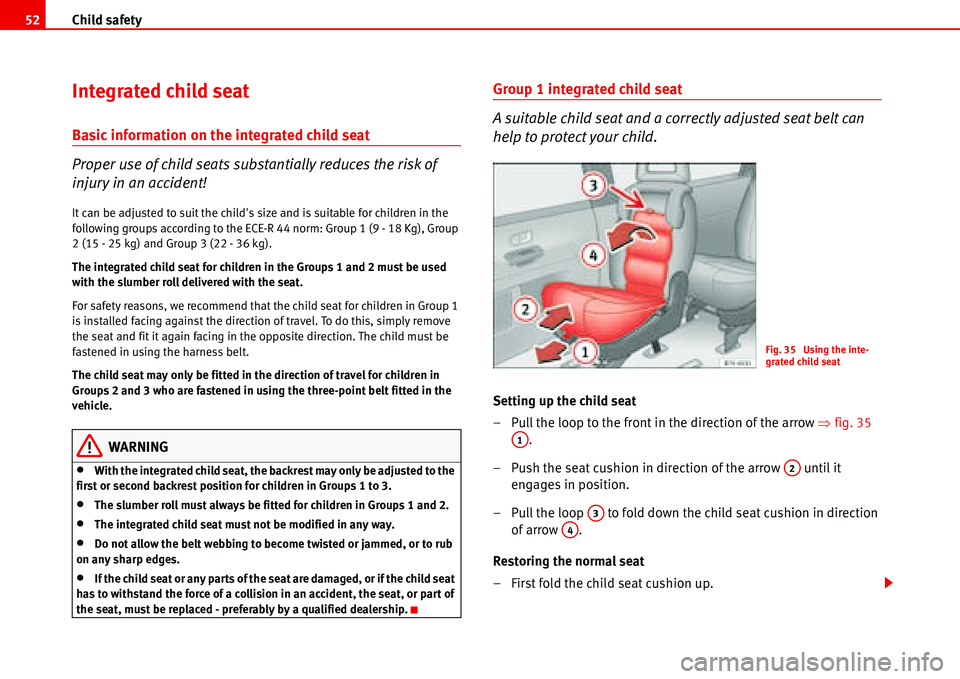
Child safety 52
Integrated child seat
Basic information on the integrated child seat
Proper use of child seats substantially reduces the risk of
injury in an accident!
It can be adjusted to suit the child's size and is suitable for children in the
following groups according to the ECE-R 44 norm: Group 1 (9 - 18 Kg), Group
2 (15 - 25 kg) and Group 3 (22 - 36 kg).
The integrated child seat for children in the Groups 1 and 2 must be used
with the slumber roll delivered with the seat.
For safety reasons, we recommend that the child seat for children in Group 1
is installed facing against the direction of travel. To do this, simply remove
the seat and fit it again facing in the opposite direction. The child must be
fastened in using the harness belt.
The child seat may only be fitted in the direction of travel for children in
Groups 2 and 3 who are fastened in using the three-point belt fitted in the
vehicle.
WARNING
•With the integrated child seat, the backrest may only be adjusted to the
first or second backrest position for children in Groups 1 to 3.
•The slumber roll must always be fitted for children in Groups 1 and 2.
•The integrated child seat must not be modified in any way.
•Do not allow the belt webbing to become twisted or jammed, or to rub
on any sharp edges.
•If the child seat or any parts of the seat are damaged, or if the child seat
has to withstand the force of a collision in an accident, the seat, or part of
the seat, must be replaced - preferably by a qualified dealership.
Group 1 integrated child seat
A suitable child seat and a correctly adjusted seat belt can
help to protect your child.
Setting up the child seat
– Pull the loop to the front in the direction of the arrow �Ÿfig. 35
.
– Push the seat cushion in direction of the arrow until it
engages in position.
– Pull the loop to fold down the child seat cushion in direction
of arrow .
Restoring the normal seat
– First fold the child seat cushion up.
Fig. 35 Using the inte-
grated child seat
A1
A2
A3
A4
Page 55 of 299
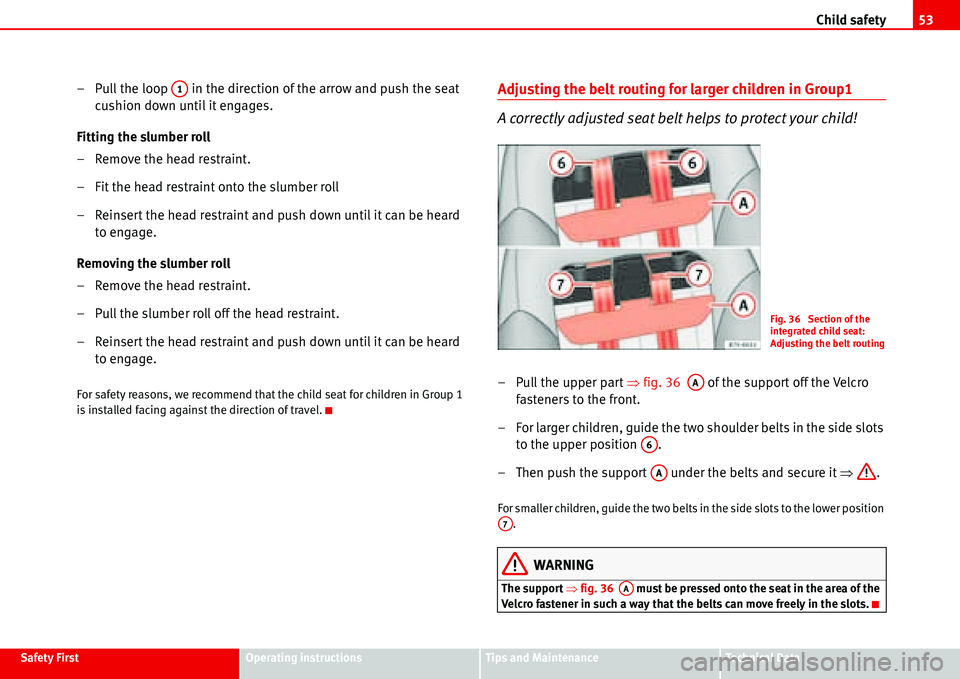
Child safety53
Safety FirstOperating instructionsTips and MaintenanceTe c h n i c a l D a t a
– Pull the loop in the direction of the arrow and push the seat
cushion down until it engages.
Fitting the slumber roll
– Remove the head restraint.
– Fit the head restraint onto the slumber roll
– Reinsert the head restraint and push down until it can be heard
to engage.
Removing the slumber roll
– Remove the head restraint.
– Pull the slumber roll off the head restraint.
– Reinsert the head restraint and push down until it can be heard
to engage.
For safety reasons, we recommend that the child seat for children in Group 1
is installed facing against the direction of travel.
Adjusting the belt routing for larger children in Group1
A correctly adjusted seat belt helps to protect your child!
– Pull the upper part �Ÿfig. 36 of the support off the Velcro
fasteners to the front.
– For larger children, guide the two shoulder belts in the side slots
to the upper position .
– Then push the support under the belts and secure it �Ÿ.
For smaller children, guide the two belts in the side slots to the lower position
.
WARNING
The support �Ÿfig. 36 must be pressed onto the seat in the area of the
Velcro fastener in such a way that the belts can move freely in the slots.
A1
Fig. 36 Section of the
integrated child seat:
Adjusting the belt routing
AA
A6
AA
A7
AA
Page 56 of 299
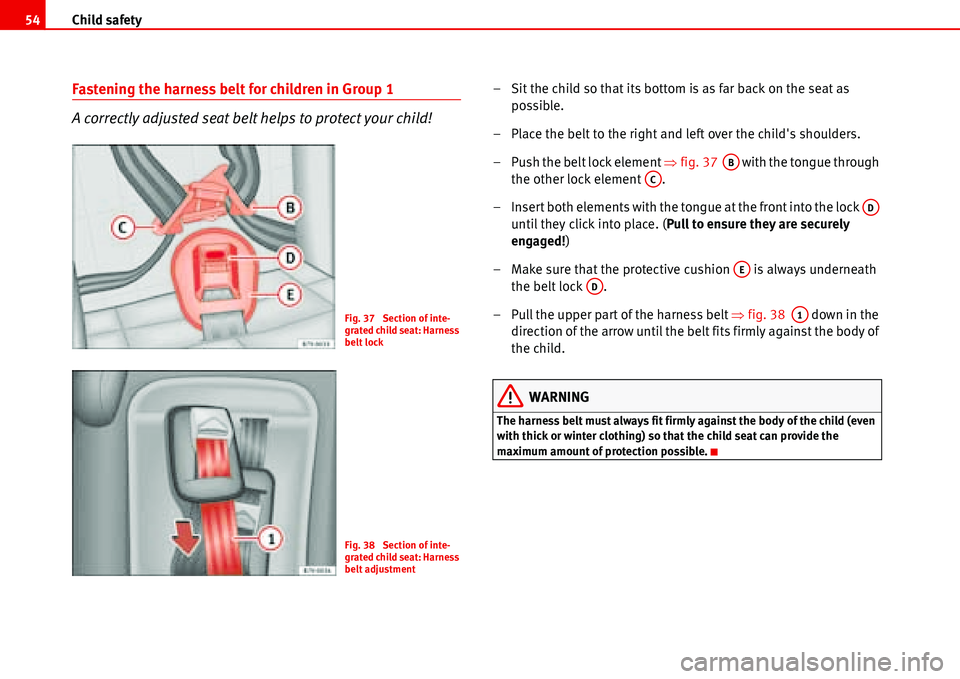
Child safety 54
Fastening the harness belt for children in Group 1
A correctly adjusted seat belt helps to protect your child!– Sit the child so that its bottom is as far back on the seat as
possible.
– Place the belt to the right and left over the child's shoulders.
– Push the belt lock element �Ÿfig. 37 with the tongue through
the other lock element .
– Insert both elements with the tongue at the front into the lock
until they click into place. (Pull to ensure they are securely
engaged!)
– Make sure that the protective cushion is always underneath
the belt lock .
– Pull the upper part of the harness belt �Ÿfig. 38 down in the
direction of the arrow until the belt fits firmly against the body of
the child.
WARNING
The harness belt must always fit firmly against the body of the child (even
with thick or winter clothing) so that the child seat can provide the
maximum amount of protection possible.
Fig. 37 Section of inte-
grated child seat: Harness
belt lock
Fig. 38 Section of inte-
grated child seat: Harness
belt adjustment
AB
AC
AD
AE
AD
A1
Page 57 of 299
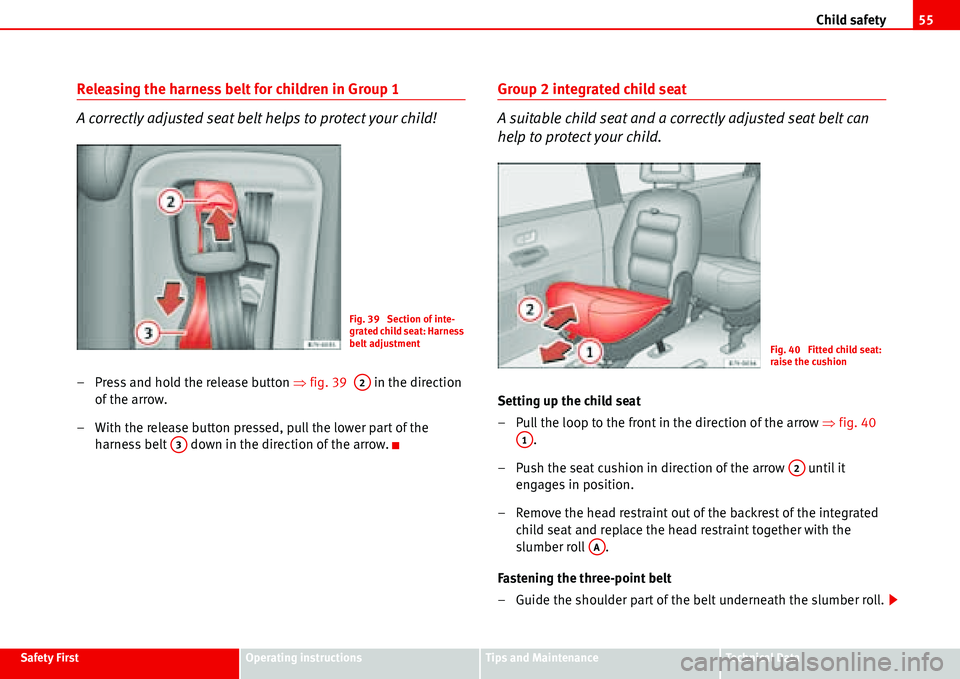
Child safety55
Safety FirstOperating instructionsTips and MaintenanceTe c h n i c a l D a t a
Releasing the harness belt for children in Group 1
A correctly adjusted seat belt helps to protect your child!
– Press and hold the release button �Ÿfig. 39 in the direction
of the arrow.
– With the release button pressed, pull the lower part of the
harness belt down in the direction of the arrow.
Group 2 integrated child seat
A suitable child seat and a correctly adjusted seat belt can
help to protect your child.
Setting up the child seat
– Pull the loop to the front in the direction of the arrow �Ÿfig. 40
.
– Push the seat cushion in direction of the arrow until it
engages in position.
– Remove the head restraint out of the backrest of the integrated
child seat and replace the head restraint together with the
slumber roll .
Fastening the three-point belt
– Guide the shoulder part of the belt underneath the slumber roll.
Fig. 39 Section of inte-
grated child seat: Harness
belt adjustment
A2
A3
Fig. 40 Fitted child seat:
raise the cushion
A1
A2
AA
Page 58 of 299
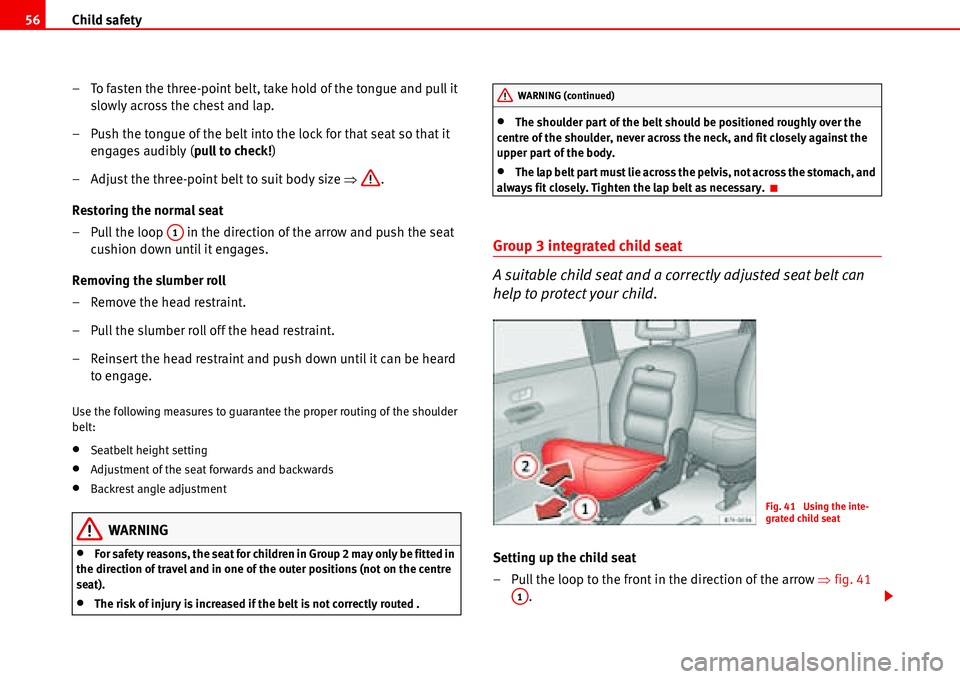
Child safety 56
– To fasten the three-point belt, take hold of the tongue and pull it
slowly across the chest and lap.
– Push the tongue of the belt into the lock for that seat so that it
engages audibly (pull to check!)
– Adjust the three-point belt to suit body size �Ÿ.
Restoring the normal seat
– Pull the loop in the direction of the arrow and push the seat
cushion down until it engages.
Removing the slumber roll
– Remove the head restraint.
– Pull the slumber roll off the head restraint.
– Reinsert the head restraint and push down until it can be heard
to engage.
Use the following measures to guarantee the proper routing of the shoulder
belt:
•Seatbelt height setting
•Adjustment of the seat forwards and backwards
•Backrest angle adjustment
WARNING
•For safety reasons, the seat for children in Group 2 may only be fitted in
the direction of travel and in one of the outer positions (not on the centre
seat).
•The risk of injury is increased if the belt is not correctly routed .
•The shoulder part of the belt should be positioned roughly over the
centre of the shoulder, never across the neck, and fit closely against the
upper part of the body.
•The lap belt part must lie across the pelvis, not across the stomach, and
always fit closely. Tighten the lap belt as necessary.
Group 3 integrated child seat
A suitable child seat and a correctly adjusted seat belt can
help to protect your child.
Setting up the child seat
– Pull the loop to the front in the direction of the arrow �Ÿfig. 41
.
A1
WARNING (continued)
Fig. 41 Using the inte-
grated child seat
A1
Page 59 of 299
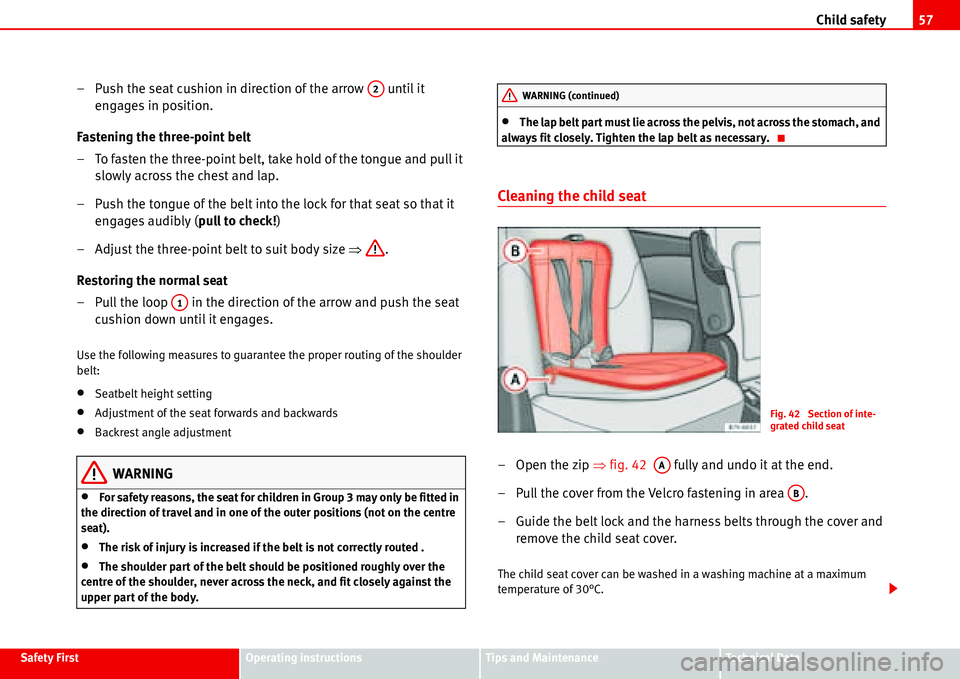
Child safety57
Safety FirstOperating instructionsTips and MaintenanceTe c h n i c a l D a t a
– Push the seat cushion in direction of the arrow until it
engages in position.
Fastening the three-point belt
– To fasten the three-point belt, take hold of the tongue and pull it
slowly across the chest and lap.
– Push the tongue of the belt into the lock for that seat so that it
engages audibly (pull to check!)
– Adjust the three-point belt to suit body size �Ÿ.
Restoring the normal seat
– Pull the loop in the direction of the arrow and push the seat
cushion down until it engages.
Use the following measures to guarantee the proper routing of the shoulder
belt:
•Seatbelt height setting
•Adjustment of the seat forwards and backwards
•Backrest angle adjustment
WARNING
•For safety reasons, the seat for children in Group 3 may only be fitted in
the direction of travel and in one of the outer positions (not on the centre
seat).
•The risk of injury is increased if the belt is not correctly routed .
•The shoulder part of the belt should be positioned roughly over the
centre of the shoulder, never across the neck, and fit closely against the
upper part of the body.
•The lap belt part must lie across the pelvis, not across the stomach, and
always fit closely. Tighten the lap belt as necessary.
Cleaning the child seat
– Open the zip �Ÿfig. 42 fully and undo it at the end.
– Pull the cover from the Velcro fastening in area .
– Guide the belt lock and the harness belts through the cover and
remove the child seat cover.
The child seat cover can be washed in a washing machine at a maximum
temperature of 30°C.
A2
A1
WARNING (continued)
Fig. 42 Section of inte-
grated child seat
AA
AB
Page 60 of 299
Child safety 58
WARNING
When refitting the child seat cover, please ensure that the cover is fitted to
the seat in the area of the Velcro fastening in such a way that the belts can
move freely in the slots.